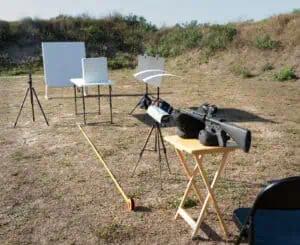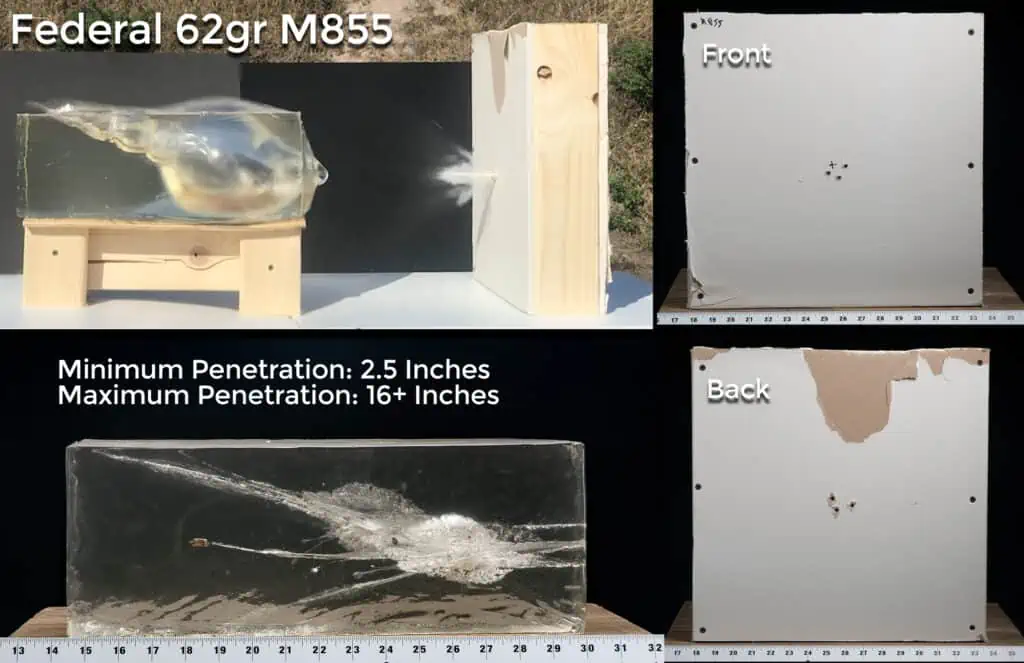Finding The Best 5.56 Ammo For Home Defense
The 5.56mm round (and its 223 Remington cousin) is one of the most popular rifle rounds in America today. This is due, in no small part, to the immense popularity and almost unlimited flexibility of the AR-15, which is commonly chambered in 5.56mm. 5.56mm is the preferred rifle round for our military as well many law enforcement civilian applications. Today we’ll be looking at the ammo options available for your AR in order to find the best 5.56mm ammo for home defense.
When it was first introduced, the 5.56 round was not known for being the most heavy-hitting cartridge on the market. Jeff Cooper, one of the most influential figures in the firearms world, used the phrase “poodle shooter,” to describe the 5.56mm, which implies it was only good for smaller animals, not man-sized targets.
Underpowered? Not Hardly
Experience has shown otherwise, and the 5.56mm round is now trusted and used by armies around the world. The popularity of the round has resulted in a wide variety of bullet weights and styles in 5.56mm / 223, ranging from high-velocity 35 grain varmint loads to 77 grain rounds designed for stability at longer ranges. We’ve already looked at how 5.56mm does as a hunting round. Now in our quest to find the best 5.56mm ammo, let’s look how it works as a home defense / personal protection round.
The Best 5.56 Ammo For The Job
Because of the wide variety of bullet weights and types of 5.56mm out there, we’ll divide all of it into one of three groups and then test representatives of each group. The three groups are:
Lightweight hunting / varmint rounds
General purpose training/ practice rounds
Heavier weight, target / match ammunition
The specific ammo we’ll be testing is
Okay, technically, this is a 223 Remington round, but you get the idea. This a lightweight hollow point bullet with a polymer tip that is designed to expand rapidly when it hits soft tissue.
The classic M193 bullet that’s been used for decades as a competition, training and defensive round. M193 was the original defensive round for AR pattern rifles, but it’s since been replaced in military use by the next round on our list.
The M855 round was developed to replace the M193 as the primary military 5.56mm cartridge. Now M855 has been replaced in turn by the heavier M855A1 round. M855 remains very popular in the civilian world, due in no small part to the availability of surplus rounds from the government.
69 Grain Fiocchi Sierra MatchKing HP
Yes, I know, another 223 load, but again, this is meant to stand in for other heavier 5.56mm rounds out there, Sierra is one of the most-trusted names in bullet design, and this round is a known performer.
Testing Home Defense Ammo
As we said before, we’ll be testing these rounds to find the best 5.56mm ammo (or 223 ammo) for home defense. A good home defense cartridge must do two things. It must stop the threat, and it must have minimal effects on innocent bystanders if you miss.
The facts and figures which show that most 5.56mm and similar ammo can stop the threat could fill up most of the internet. As such, we’ll be concentrating on that second part initially, and then circle back to how 5.56 stops the threat (or not). The rifle we’ll be using is a homebuilt AR-15 with a 16 inch long, 1 in 8 twist barrel. This is a very common length and twist rate. It should provide us with a neutral platform to use with our ammo.
It’s What’s Inside That Counts
 To test what happens when you miss with a round of 5.56mm ammo inside of a typical American home, we’re going to recreate the interior of a home, shoot rounds through one wall and then have them impact ballistic gelatin on the other side of that wall. We’ll also set up another larger wall to see what happens if any of the rounds make it through the testing medium.
To test what happens when you miss with a round of 5.56mm ammo inside of a typical American home, we’re going to recreate the interior of a home, shoot rounds through one wall and then have them impact ballistic gelatin on the other side of that wall. We’ll also set up another larger wall to see what happens if any of the rounds make it through the testing medium.
We’ll be using walls that are built from common construction materials like 2×4 pine lumber and ½” drywall. We built them using common construction methods. The testing medium we’ll be using is a 16 inch block of ballistics gel, a very common means of testing bullet performance and penetration. FBI testing protocols show that a projectile which penetrates more than 12 inches into ballistics gel has a very high chance of being a lethal hit. The best 5.56 ammo for home defense should therefore be able to stop a threat to our lives, but not be a threat to innocent life if we miss.
What Makes The 5.56 Round Effective
Let’s pause for a moment to talk about what makes the 5.56 an effective defensive round. 5.56 ammo tends to use bullets with a low ballistic coefficient and sectional density. It shoots them out at high velocity. In layman’s terms, that means they’re skinny, very aerodynamic and travel very fast. As a result, when they hit something that’s more dense than the air, they lose their stability quickly, tumble end over end and can even fragment into many pieces.
Larger, slower bullets (like from a pistol) act differently, Those tend to push right through when they impact the target, relying on the design of their bullet to open up and transfer the energy of their motion to the target. The ability of a 5.56mm round to destabilize and tumble through the target is one of the reasons why it’s become such a popular round for all sorts of defensive applications. However, as we shall see, there are exceptions to his rule.
Now let’s go at the test results.
Black Hills 40 Grain TSX
Average Muzzle Velocity: 3086 fps
Minimum Gel Penetration: 0.75 inches
Maximum Gel Penetration: 16+ inches
Struck Rear Wall: N
Penetrated Rear Wall: N
This round had a drastic effect on the ballistics gel, literally ripping the first few inches to shreds. Each bullet immediately began to destabilize and fragment when it hit the first wall. The bullets split apart into a myriad of pieces, coming to rest almost immediately in the gel. This is exactly what you want from a round that’s designed to hunt gophers, groundhogs and other small pests, but it probably falls a bit short of the performance you need to save your life. Most shooters will opt for a bullet that offers more consistent penetration.
Federal 55 grain M193 FMJ
Average Muzzle Velocity: 3027 fps
Minimum Gel Penetration: 1.5 inches
Maximum Gel Penetration: 12.5 inches
Struck Rear Wall: N
Penetrated Rear Wall: N
We were honestly surprised by how quickly this round started to destabilize. A close examination of the front of the gel showed that two of the three bullets actually entered the gel sideways: The impact with the first two sections of drywall was enough to start them tumbling. As a result, on average, it penetrated just slightly over the FBI minimum into the ballistics gel.
62 Grain M855
Average Muzzle Velocity: 3014 fps
Minimum Gel Penetration: 2.5 inches
Maximum Gel Penetration: 16+ inches
Struck Rear Wall: Y
Penetrated Rear Wall: N
The M855 round has a tip that is specifically designed for barrier penetration, and that’s exactly what this round did in our tests. M855 was the only round of the four we tested which went through the front two sections of drywall and all the way through the testing medium. In addition to this, each round deviated significantly when it hit the ballistics gel. One round impacted on the far side of our four foot wide rear wall, one impacted the other edge, and the third missed the wall entirely. Both of the rounds that impacted the rear wall hit one of the 2×4 stringers, so we were unable to determine if those two rounds would have gone past the rear wall.
69 Grain Fiocchi Sierra MatchKing HP
Average Muzzle Velocity: 2400 fps
Minimum Gel Penetration: 6.5 inches
Maximum Gel Penetration: 13.5 inches
Struck Rear Wall: N
Penetrated Rear Wall: N
A 69 grain bullet is approaching the top end of 5.56 ammo, and the MatchKing round is an open tip match (OTM round). As such, we were expecting this round to slow down through expansion, rather than tumbling. Imagine our surprise when the round not only tumbled, but performed at a level very similar to the lighter weight 55 grain FMJ round.
What is the Best 5.56 Ammo For Home Defense?
Let’s go back to our original parameters. An effective 5.56mm home defense round must stop the threat and minimize the threat to innocent life. The 40 grain varmint round certainly did minimal damage to our testing medium. However, I’m not sure I’d rely on it to penetrate into the target and cause a wound that would stop a threat.
On the other hand, the M855 round did exactly the opposite, which is not surprising for a round that was designed to go through barriers. M855 is useful in other situations such as punching through cover and concealment, but its utility in those situations means it’s not the best 5.56 ammo to use inside the home.
This brings us to the last two rounds in our test, the 55 grain M193 and the 69 grain Fiocchi. Both are terrific rounds, and they did about the same amount of damage to our testing medium. The 69 grain MatchKing is a proven hunting and target round, and 55 grain M193 has years of effective use by both law enforcement and military. However, M193 is less expensive per round than the Fiocchi ammo. This means you can practice with the same ammo you use for personal protection, giving you more confidence when lives are on the line. As such, based on these results, we’d recommend M193 as the best 5.56 ammo for personal protection inside the home.
What do you think? Did we get it right? Sound off in the comments below.







In this day and age the best round is whatever you can find,
For an article that was supposed to give us the author’s findings on purpose built home defense 5.56 rounds, none were used in this test. What we got was; what is the best standard 5.56 round to use for home defense.
Depending on your current barrel length and platform, your best bet is going to be middle of the road bonded soft points, anywhere from 60-72 grain. Speer makes an amazing bsp at both 62 & 75g that will greatly perform within a wide range of velocity, allowing the round to have a much wider window to perform as intended for velocities sake. Speer themselves say that the round will still reliably expand all the way down to 1400fps. So even if you have a 10-14″ barrel the round will still be beyond deadly.
If you’re not into bsp then your next best option is going to be heavy otm type rounds, primarily 75-77g. Those rounds perform amazingly within cqb / home defense scenarios but when pushed to further distances they fall off very quickly….
If money is an issue then simply stick with M193 from imi / Winchester / Federal or PPU. They still load the M193 to higher pressure while everyone else has severly neutered their loadings.
Any test that leaves out the MK 262 or other heavy OTM bullets is not a legitimate Home Defense load test by any means. Being that the best are pretty much 70 grain and heavier OTM and SP.. 69 Grain does not get the job done nearly as well as 77 or 75 grain, especially coming from a pistol or carbine..
I would have liked to at least see how 1 round from each example did strictly through the gel before having to then deal with barriers. It’s extremely hard to judge a rounds characteristics as far as terminal ballistics are concerned when first the round has to defeat the barriers in place like in your testing. It’s extremely rare that we’ll find ourselves blindly shooting through walls in hopes to stop whatever threat is on the other side. If the testing was STRICTLY for the results of how the rounds behave through barriers then okay, I can see the point…. But to base a decision on “best” home defense round through such testing is rather odd, especially with the final decision and winner of said test.
I’d like to see the results with the round going into the gel and damage to surrounding structure after exiting the gel. I don’t think people shoot through walls to hit their target every time.
Good article as far as it went but missed the boat as far as outright terminal effect before going through ballistic gel. We are left to infer their defensive capabilities only AFTER passing through a barrier. I do appreciate the conclusion that the most widely available and economical ammo is good for practice and loadout.